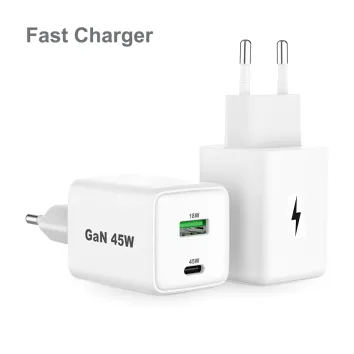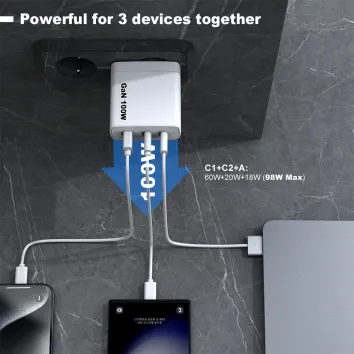Charger Manufacturer Guide: What Are Standard and Non-Standard Chargers?
When it comes to charging your devices, not all chargers are created equal. As a professional charger manufacturer and OEM supplier, we often get asked:
“What’s the difference between standard and non-standard chargers?”
This question is critical — not only for consumer safety but also for product reliability, certification, and brand trust.
Let’s dive into the essential differences between standard and non-standard chargers, how to identify them, and why using the wrong one can damage your devices.

✅ What Is a Standard Charger?
A standard charger is a power adapter that complies with international safety certifications, supports advanced USB-C PD fast charging protocols, and is manufactured with premium components.
“What’s the difference between standard and non-standard chargers?”
This question is critical — not only for consumer safety but also for product reliability, certification, and brand trust.
Let’s dive into the essential differences between standard and non-standard chargers, how to identify them, and why using the wrong one can damage your devices.

✅ What Is a Standard Charger?
A standard charger is a power adapter that complies with international safety certifications, supports advanced USB-C PD fast charging protocols, and is manufactured with premium components.
These chargers are manufactured by professional charger factories with the following characteristics:
·✅ Porducts Certified: CE, UL, FCC, RoHS, KC
·✅ Protocol Support: USB Power Delivery (PD), Quick Charge (QC), Programmable Power Supply (PPS)
·✅ Real Output Power: e.g., 65W USB-C PD verified
·✅ Protection Circuitry: over-voltage, over-current, short circuit, overheat
·✅ Stable Output: designed with intelligent charging ICs
💡 These are the chargers built by real GaN fast charger factories and OEM-certified power adapter manufacturers.
⚠️ What Is a Non-Standard Charger?
A non-standard charger (also known as counterfeit, knock-off, or uncertified charger) fails to meet global safety and power delivery standards. It may appear similar on the surface but lacks the internal protections and accurate power management. Are low-cost alternatives that often cut corners in components, protection, and compliance.
Common problems include:
·❌ No compliance certifications (or fake ones)
·❌ Claims fast charging but only delivers 5V/1A (Like:5V/1.5A Write as 5V/2A)
·❌ Lacks USB-C PD handshake protocols
·❌ Uses inferior materials and fake ICs
·❌ Prone to overheating or current spikes (no temperature or current control)
These chargers may work initially, but they pose serious risks in long-term use.
🔍 How to Identify Standard vs Non-Standard Chargers
Here’s a quick comparison table to help you identify charger types when sourcing or purchasing in bulk:
| Feature | Standard Chargers | Non-Standard Chargers |
| Certifications | CE,FCC,UL,RoHs,KC,KCC,GRS, etc | Often none or fate |
| Supported Protocols | USB PD, QC3.0/4.0, PPS | Fate PD, basic 5V output |
| Output Stability | Intelligent chip-controlled | Unstable, spikes in voltage |
| Build Materials | V1 fireproof PC, copper coils | Cheap plastic, aluminum wiring |
| Heat Management | Smart temperature protection (NTC/NTC) | Lacks heat sensors or fuses |
| Manufacturer Traceability | Verified factory/OEM background | Unknown or rebranded from low-cost |
| Labeling & Data | Accurate power info (e.g. 65W PD) | Often mislabeled ("35w,45w,65w,100w,more" ≠ Ture) |

🔥 The Hidden Dangers of Non-Standard Chargers
Using non-standard or uncertified chargers may save cost upfront, but the long-term damage far outweighs the initial savings:
🔋 Shortened battery lifespan: Over-voltage and unstable current will degrade your device’s lithium battery faster.
🔥 Fire and overheating risks: Lack of thermal regulation can cause serious overheating, especially with overnight charging.
💥 Device failure or motherboard burn: Incompatible handshake protocols can send the wrong voltage, frying sensitive components.
⚡ Slow or no charging: Poor contact points, outdated chips, or lack of USB-C compatibility result in unreliable performance.
🧯 No Warranty Support – Many brands refuse warranty if damage caused by 3rd-party charger
📌Pro Tip: If a charger feels suspiciously light, lacks visible certification labels, or is unusually cheap — it’s probably non-standard.
🏭 Why You Should Source From a Certified Charger Factory
As a professional USB-C PD charger manufacturer, we ensure:
·📦 Use of authentic power management ICs and certified GaN components
·🔬 Rigorous testing for voltage stability, safety, and heat resistance
·✅ Compliance with CE, FCC, UL, KC, RoHS, and more
·🔌 Compatibility with Apple, Samsung, Huawei, Lenovo, Dell, and more
Using non-standard or uncertified chargers may save cost upfront, but the long-term damage far outweighs the initial savings:
🔋 Shortened battery lifespan: Over-voltage and unstable current will degrade your device’s lithium battery faster.
🔥 Fire and overheating risks: Lack of thermal regulation can cause serious overheating, especially with overnight charging.
💥 Device failure or motherboard burn: Incompatible handshake protocols can send the wrong voltage, frying sensitive components.
⚡ Slow or no charging: Poor contact points, outdated chips, or lack of USB-C compatibility result in unreliable performance.
🧯 No Warranty Support – Many brands refuse warranty if damage caused by 3rd-party charger
📌Pro Tip: If a charger feels suspiciously light, lacks visible certification labels, or is unusually cheap — it’s probably non-standard.
🏭 Why You Should Source From a Certified Charger Factory
As a professional USB-C PD charger manufacturer, we ensure:
·📦 Use of authentic power management ICs and certified GaN components
·🔬 Rigorous testing for voltage stability, safety, and heat resistance
·✅ Compliance with CE, FCC, UL, KC, RoHS, and more
·🔌 Compatibility with Apple, Samsung, Huawei, Lenovo, Dell, and more
📈 Whether you're in B2B sourcing, e-commerce wholesale, or building your own charger brand, working with a certified charger factory helps you avoid product returns, brand complaints, and user safety risks.
👉Read more about how GaN charger safety works

🧠 Pro Tips to Identify a True Standard Charger
1. Check Labels: Look for proper CE/FCC/UL marks with matching documentation
2. Weight & Build: Heavier = more components. Fake chargers feel hollow
3. Output Specs: Real 65W charger supports PD 3.0, not just “fast charge” claims
4. Port Layout: USB-C PD ports come with dynamic negotiation chips (not just “Type-C”)
5. Ask for Factory Certifications: Legitimate OEM charger suppliers will provide test reports
🧩 Final Thoughts: Safety, Compliance, and Long-Term Performance
A standard USB-C charger is more than a plug — it’s a precision-engineered power device. If you’re sourcing from a charger OEM, or planning to resell high-quality chargers, always demand compliance, traceability, and intelligent protocol support. Choose a certified factory with real charging expertise.
Your device deserves more than “just charging” — it deserves safe, smart, and certified charging.
🔗 Related Internal Blog Articles
·Why GaN Fast Chargers Are Safer and Smaller
·How to Choose the Right PD Charger for Laptops and Phones
·The Real Meaning Behind USB-C PD, QC, and PPS Explained

Leggi di più

Leggi di più

Caricatore GAN per iPhone Samsung Apple Laptop
Leggi di più